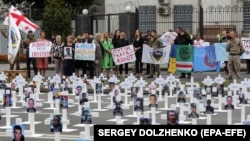A London-based digital forensics agency says it has gathered an enormous body of evidence that Russia’s military was deployed in the August-September 2014 fighting around Ilovaysk, in eastern Ukraine, in which Ukrainian forces were defeated by combined Russian and separatist troops.
Forensic Architecture used "machine learning and computer vision" to amass “the most comprehensive collection of evidence for the presence of Russian military personnel and hardware throughout the battlefield,” its project website states.
Russia has denied involvement in the Donbas conflict that erupted in April 2014 and has killed more than 13,000 people. After annexing Ukraine’s Crimean Peninsula earlier in 2014, Moscow has rejected allegations of leading, fighting beside, training, and supplying separatists in eastern Ukraine.
The group was hired by the British-based European Human Rights Advocacy Center (EHRAC) in September 2018 to assist with litigation against Russia by Ukrainian volunteer fighters at the European Court of Human Rights (ECHR), The Guardian reported on August 18.
An EHRAC news release to announce the hiring said, “29 members of a Ukrainian volunteer battalion were…surrounded and taken captive by Russian armed forces, and transferred into the hands of ‘separatists,’” during the battle.
The Guardian reported 25 of the volunteers were members of the Donbas battalion, whose members were predominantly from the easternmost regions of Luhansk and Donetsk when it was formed.
The Ukrainian prisoners were subsequently “verbally and physically abused, stripped of their belongings and…put to forced labor” for several months during their captivity, the news release alleges.
The evidence of Russian military presence in the fighting around Ilovaysk will be used in their case and signifies the first time “that EHRAC has relied on such innovative techniques to substantiate our arguments,” the human rights group said.
Forensic Architecture said it found “evidence of almost 300 Russian military vehicles around the Ukrainian towns of Ilovaysk and Luhansk.”
It used a machine-learning classifier to analyze 2,500 hours of video frame by frame on YouTube as well as other open-source material, including findings by British online investigators Bellingcat.
Forensic Architecture refined the classifier to focus on tanks, in particular the 2012 model of Russia’s modified T-72B3 tank.
At the time of the battle of Ilovaysk, this tank was used exclusively by the Russian Army and never exported to Ukraine.
The digital investigator identified columns of Russian military vehicles entering Ukraine’s Donetsk region in late August 2014, including several sightings of the T-72B3 tank ahead of the battle.
Their entry, including a simultaneous thrust into the Luhansk region in the northeast, was preceded that summer by cross-border shelling from Russia that decimated Ukrainian border-guard outposts and military units stationed near the border, according to findings by Bellingcat and the Ukrainian military.
Russia denies shelling Ukraine from its side of the border.
Ukraine currently doesn’t control more than 400 kilometers of its eastern border with Russia.
Ukraine’s military said that 366 soldiers were killed in the fighting around Ilovaysk, not counting fighters from volunteer battalions, and that an additional 158 combatants went missing.
Many of the losses came after the Ukrainian units were surrounded and then attacked when they tried to retreat during a confusing cease-fire that had been brokered with Russian officers.
Preliminary findings by a Ukrainian parliamentary ad hoc committee afterward said that up to 1,000 Ukrainian soldiers may have been killed in the battle. It blamed the military leadership, mainly ex-Defense Minister Valeriy Heletey and chief of the general staff, Viktor Muzhenko, for organizing a poor defense and making miscalculated decisions.
Both officers defended their actions and laid the blame on what they called insubordinate volunteer battalion units during the fighting.
The battlefield loss forced then-President Petro Poroshenko to the negotiating table in Minsk, Belarus to hastily reach a cease-fire agreement with Russian President Vladimir Putin in talks that were mediated by German Chancellor Angela Merkel and then-President Francois Hollande of France.
Approximately 4,000 applications have been filed with the ECHR related to the Donbas conflict and the annexation of Crimea, many of which have been lodged against both Russia and Ukraine.
The volunteer fighters in Ilovaysk are also suing Ukraine at the court for alleged “negligent planning of a military operation,” The Guardian reported.
The ECHR will first preside over interstate cases lodged by Ukraine against Russia before ruling on individual cases related to the conflict.












